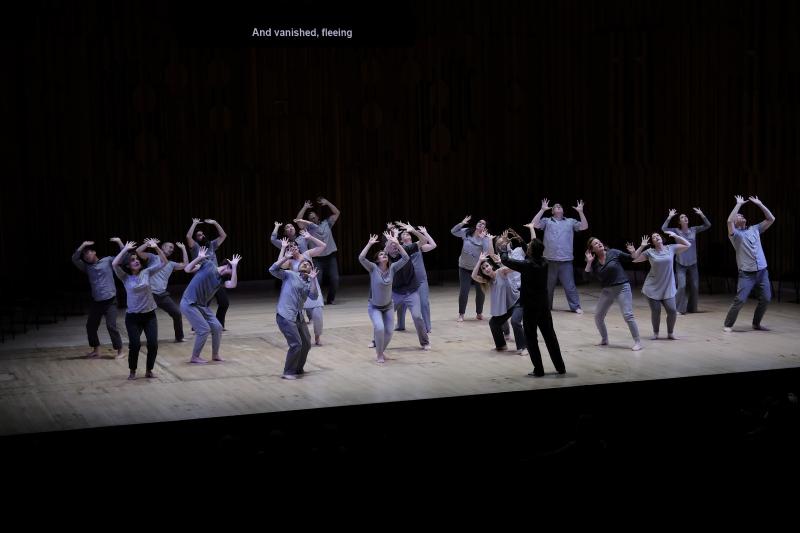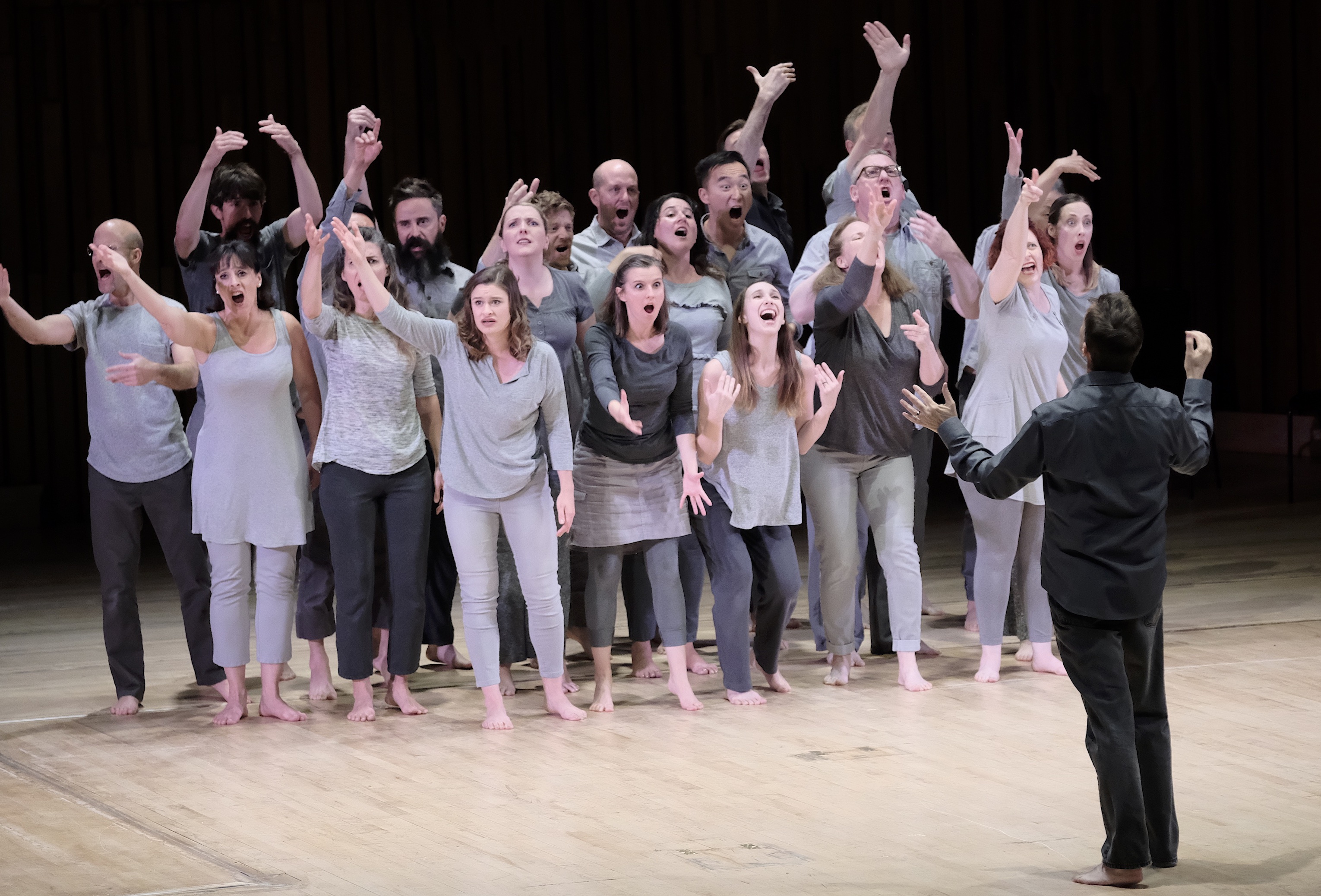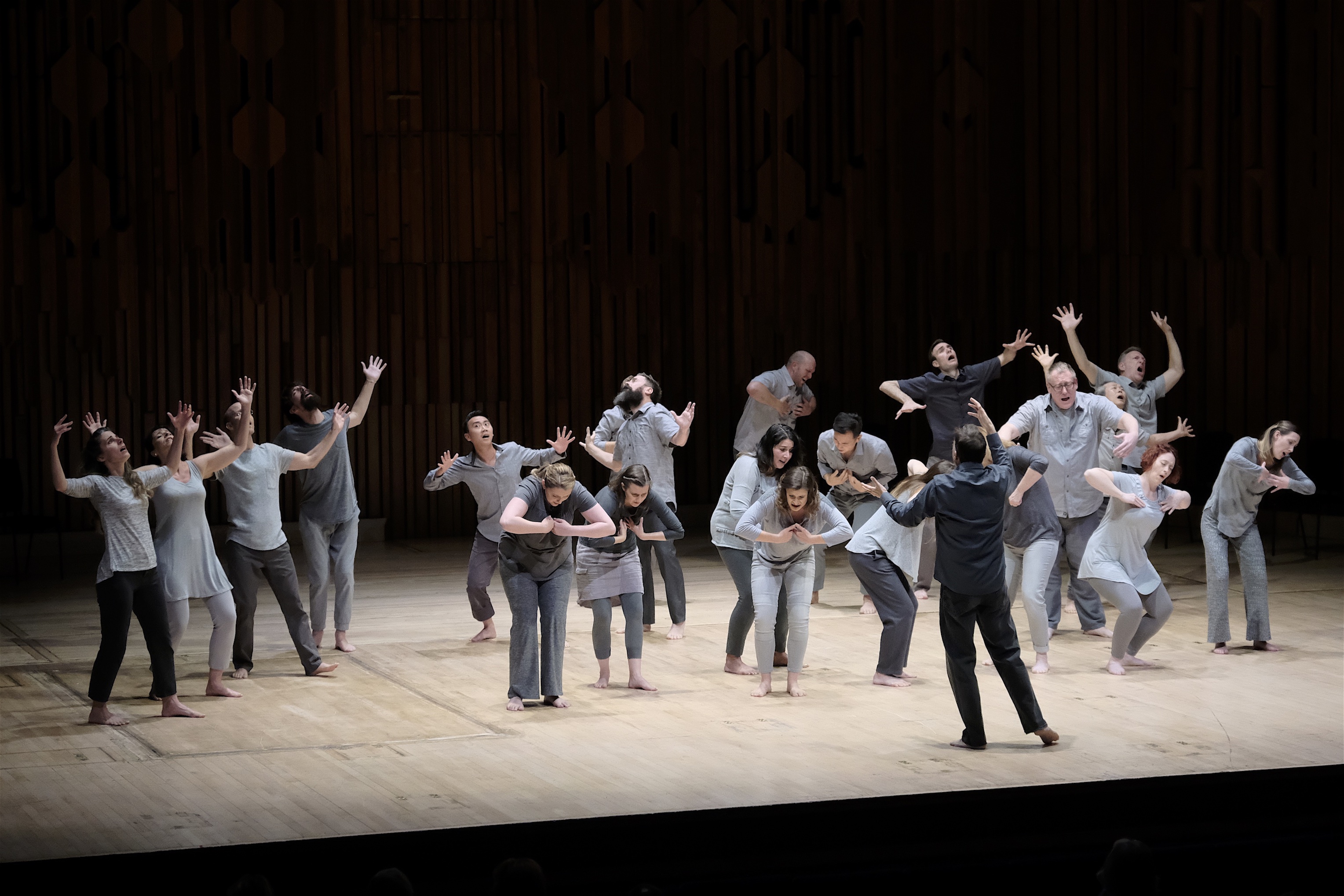Los Angeles Master Chorale, Gershon, Sellars, Barbican review – embodiments of remorse | reviews, news & interviews
Los Angeles Master Chorale, Gershon, Sellars, Barbican review – embodiments of remorse
Los Angeles Master Chorale, Gershon, Sellars, Barbican review – embodiments of remorse
Grandeur, and fussiness, in Peter Sellars' staging of a choral masterwork

By some strange alignment of the stars, Peter Sellars’s staged version of Orlando di Lasso’s Lagrime di San Pietro (Tears of St Peter) arrived at the Barbican Hall just as – next door in the theatre – Pam Tanowitz’s directed her dance interpretation of TS Eliot’s Four Quartets.
Lasso, a Netherlandish composer schooled in Italy and working for decades in Munich, completed the Lagrime in his final years (he died in 1594). Though not without its passages of soaring vocal spectacle, its stripped-down and harmonically focused style feels distant from the gorgeous, sensuous intricacy of other masterpieces of late-Renaissance polyphony. Setting 20 texts by the poet Luigi Tansillo as “spiritual madrigals”, and a final motet with words by Philippe de Grève, the Lagrime shapes variations of the theme of the aged Apostle’s bitter remorse as he dwells on his triple betrayal of Jesus (“Before the cock crow, thou shalt deny me thrice,” as Matthew’s gospel says.)
 With its compact and intense a cappella writing for seven parts (each of them given three voices in the Sellars-Gershon staging), the music fiercely embodies Edward Said’s concept of “late style”, as a bold and fearless shedding of superfluities in art to reach the charged essence of meaning and experience. Lacerating sorrow, grief and self-punishment flow through the 21 sections in a beautiful but comfortless musical testament which (as Gershon notes) some recordings have smothered in a misplaced vocal prettiness.
With its compact and intense a cappella writing for seven parts (each of them given three voices in the Sellars-Gershon staging), the music fiercely embodies Edward Said’s concept of “late style”, as a bold and fearless shedding of superfluities in art to reach the charged essence of meaning and experience. Lacerating sorrow, grief and self-punishment flow through the 21 sections in a beautiful but comfortless musical testament which (as Gershon notes) some recordings have smothered in a misplaced vocal prettiness.
It sounds tough, and the Beckett-like austerity of Sellars’s staging – as in his productions of Bach’s Matthew and John Passions – gives little relief. The singers wear shades of drab, institutional grey. Chairs ringed around the big Barbican stage offer the only visual adornment, apart from the central screen for surtitles. Purged, like the music, of all external fripperies, the staging makes room above all for movement. Against the stillness and solemnity of the vocal mode, Sellars puts his singers through a punishing exercise regime. Especially in the first half of the madrigali spirituali, he keeps the choir not only on their toes but (pretty often) on their knees, crouched or hunched, and even – more than once – flat out on the floor. As restless and tormented as Peter’s anguished conscience, they prowl around the stage, split into larger or smaller sub-groups, then into pairs, before coalescing again into a single entity. Hand gestures, meanwhile, run the gamut from angry pointing to head-clutching despair, heaven-seeking outstretched arms, and the twisting, scourging actions that recall Christ’s own anguish on the way to the cross.
All the while, constantly on the move, the – consistently fine – Los Angeles choir must keep the multiple strands of Lasso’s score tightly bound together. They must vary emphasis, tone and volume as the emotions of the settings shift. Gershon, too, has to travel the expanses of the stage and conduct from a bewildering variety of spots (sometimes on his knees, when the singers writhe at ground level). So Sellars has set his collaborators a truly formidable task. And they do rise superbly to the challenge, even if I felt on occasions that all this incessant action created a needless sense of frantic busy-ness. At times it detracted from the contemplative sorrow of the work.
In fact, Lasso’s severely lovely writing can often sound less overtly mimetic than much Renaissance polyphony. Sellars, though, has the choir act out extremes of feeling with his elaborate dumbshow performances, from those scenes of scourging, to quarrels and embraces between couples, and the shaking palpitations of prostrate sufferers as despair and self-loathing knock them to the floor.
 To keep the shape and direction of the vocal lines so clear when engaged in all this athletic choreography – and to charge them with the extra drama of sudden shifts in volume – was beyond doubt an awe-inspiring achievement. However, the relentless mobility required of the singers, as Sellars endlessly shuffled his pack, necessarily meant that he scrambled the part-writing as the seven gangs of three subdivided or converged into mutating cells of differing size. Sometimes I yearned for a simpler staging to let the music breathe. And, over the final seven madrigals, he did provide that, as the singers returned to their hemicycle of chairs.
To keep the shape and direction of the vocal lines so clear when engaged in all this athletic choreography – and to charge them with the extra drama of sudden shifts in volume – was beyond doubt an awe-inspiring achievement. However, the relentless mobility required of the singers, as Sellars endlessly shuffled his pack, necessarily meant that he scrambled the part-writing as the seven gangs of three subdivided or converged into mutating cells of differing size. Sometimes I yearned for a simpler staging to let the music breathe. And, over the final seven madrigals, he did provide that, as the singers returned to their hemicycle of chairs.
Now we could hear the changing sonic balance and stress of the settings carry the weight of feeling in itself, rather than Sellars insisting on its embodiment in stretched limbs and clenched muscles. That said, the final, tentative transition from solitary regret to the hope of forgiveness proved immensely moving. The choir divided into two lines which then, slowly, edged towards a final embrace. For all the over-strenuous acting-out that had preceded it, this closing motet did vindicate the Sellars vision. Music and movement fused into a radiant glimpse of redemption.
rating
Explore topics
Share this article
The future of Arts Journalism
You can stop theartsdesk.com closing!
We urgently need financing to survive. Our fundraising drive has thus far raised £49,000 but we need to reach £100,000 or we will be forced to close. Please contribute here: https://gofund.me/c3f6033d
And if you can forward this information to anyone who might assist, we’d be grateful.

Subscribe to theartsdesk.com
Thank you for continuing to read our work on theartsdesk.com. For unlimited access to every article in its entirety, including our archive of more than 15,000 pieces, we're asking for £5 per month or £40 per year. We feel it's a very good deal, and hope you do too.
To take a subscription now simply click here.
And if you're looking for that extra gift for a friend or family member, why not treat them to a theartsdesk.com gift subscription?
more Classical music
 Jakub Hrůša and Friends in Concert, Royal Opera review - fleshcreep in two uneven halves
Bartók kept short, and a sprawling Dvořák choral ballad done as well as it could be
Jakub Hrůša and Friends in Concert, Royal Opera review - fleshcreep in two uneven halves
Bartók kept short, and a sprawling Dvořák choral ballad done as well as it could be
 Monteverdi Choir, ORR, Heras-Casado, St Martin-in-the-Fields review - flames of joy and sorrow
First-rate soloists, choir and orchestra unite in a blazing Mozart Requiem
Monteverdi Choir, ORR, Heras-Casado, St Martin-in-the-Fields review - flames of joy and sorrow
First-rate soloists, choir and orchestra unite in a blazing Mozart Requiem
 Cho, LSO, Pappano, Barbican review - finely-focused stormy weather
Chameleonic Seong-Jin Cho is a match for the fine-tuning of the LSO’s Chief Conductor
Cho, LSO, Pappano, Barbican review - finely-focused stormy weather
Chameleonic Seong-Jin Cho is a match for the fine-tuning of the LSO’s Chief Conductor
 Classical CDs: Shrouds, silhouettes and superstition
Cello concertos, choral collections and a stunning tribute to a contemporary giant
Classical CDs: Shrouds, silhouettes and superstition
Cello concertos, choral collections and a stunning tribute to a contemporary giant
 Appl, Levickis, Wigmore Hall review - fun to the fore in cabaret and show songs
A relaxed evening of light-hearted fare, with the accordion offering unusual colours
Appl, Levickis, Wigmore Hall review - fun to the fore in cabaret and show songs
A relaxed evening of light-hearted fare, with the accordion offering unusual colours
 Lammermuir Festival 2025, Part 2 review - from the soaringly sublime to the zoologically ridiculous
Bigger than ever, and the quality remains astonishingly high
Lammermuir Festival 2025, Part 2 review - from the soaringly sublime to the zoologically ridiculous
Bigger than ever, and the quality remains astonishingly high
 BBC Proms: Ehnes, Sinfonia of London, Wilson review - aspects of love
Sensuous Ravel, and bittersweet Bernstein, on an amorous evening
BBC Proms: Ehnes, Sinfonia of London, Wilson review - aspects of love
Sensuous Ravel, and bittersweet Bernstein, on an amorous evening
 Presteigne Festival 2025 review - new music is centre stage in the Welsh Marches
Music by 30 living composers, with Eleanor Alberga topping the bill
Presteigne Festival 2025 review - new music is centre stage in the Welsh Marches
Music by 30 living composers, with Eleanor Alberga topping the bill
 Lammermuir Festival 2025 review - music with soul from the heart of East Lothian
Baroque splendour, and chamber-ensemble drama, amid history-haunted lands
Lammermuir Festival 2025 review - music with soul from the heart of East Lothian
Baroque splendour, and chamber-ensemble drama, amid history-haunted lands
 BBC Proms: Steinbacher, RPO, Petrenko / Sternath, BBCSO, Oramo review - double-bill mixed bag
Young pianist shines in Grieg but Bliss’s portentous cantata disappoints
BBC Proms: Steinbacher, RPO, Petrenko / Sternath, BBCSO, Oramo review - double-bill mixed bag
Young pianist shines in Grieg but Bliss’s portentous cantata disappoints
 theartsdesk at the Lahti Sibelius Festival - early epics by the Finnish master in context
Finnish heroes meet their Austro-German counterparts in breathtaking interpretations
theartsdesk at the Lahti Sibelius Festival - early epics by the Finnish master in context
Finnish heroes meet their Austro-German counterparts in breathtaking interpretations
 Classical CDs: Sleigh rides, pancakes and cigars
Two big boxes, plus new music for brass and a pair of clarinet concertos
Classical CDs: Sleigh rides, pancakes and cigars
Two big boxes, plus new music for brass and a pair of clarinet concertos

Add comment